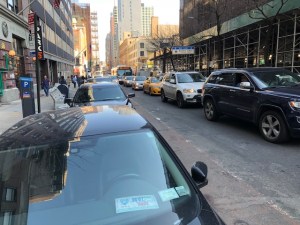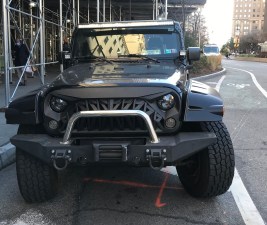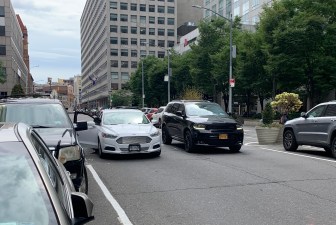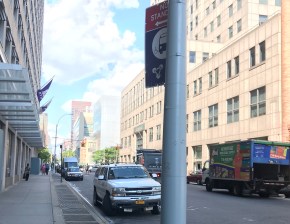Jay Street Busway Will Do More To Stop Placard Abuse Than the NYPD Ever Did
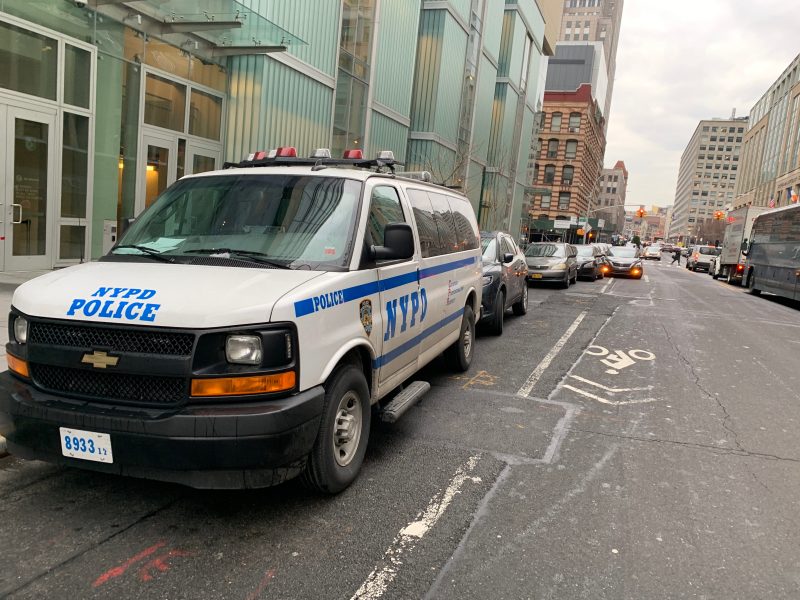
The Jay Street Busway won’t just seamlessly move tens of thousands of bus riders through Downtown Brooklyn when it’s created later this year. It will also forcefully expel scores of placard abusers in a way that the city has never been able to.
A stunning fact about the Department of Transportation’s Jay Street plans at a community presentation recently: two out of every three parked cars on the stretch between Livingston and Tillary streets had “parking permits” in their windshield — and more than one-third of them were total shams, including fugazy permissions slips such as safety vests, letters and forged or fabricated permits.
Double-parking is rampant and, as a result, bus speeds are among the lowest in the borough: below five miles per hour during the morning and evening rush and even slower during the middle of the day. [PDF]
Jay Street, which is near multiple courts, has long been a hotspot for placard abuse, as Streetsblog coverage from 2014, 2016 and 2020 has shown — and no amount of tilting at this ultimate deblasian windmill has changed that (indeed, the de Blasio administration recently surrendered to the problem, eliminating the NYPD’s placard abuse division and the DOT’s placard abuse enforcement team in order to save a few million dollars due to the coronavirus-related budget crunch. (City Hall says a new effort will roll out … next year.)

But perhaps no special effort is needed beyond barring cars from certain roadways. The DOT presentation on the Jay Street busway, which will require local traffic to make the first possible right turn off the roadway as on 14th Street, will eliminate parking along the stretch. (The presentation calls that “Creative reuse of curb,” which would include “additional bike corrals” and “potential for other uses that physically prevent illegal placard parking.” The protected bike lane between Willoughby and Johnson streets will finally add the final block to Tillary Street, a site of intense placard abuse.)
The DOT presentation even helpfully pointed out there are three parking garages with 1,300 parking spots surrounding Jay Street, which should more than make up for the spots on the reconfigured road, even if it means that putting a FRIEND OF THE VALLEY STREAM FIRE DEPARTMENT placard on your dashboard doesn’t allow you to park there for free.
And while the most important part about the busway is that it will speed up bus rides for 35,000 daily riders on seven bus routes, organizers are happy to hear it will also uproot placard abusers once it is installed in August.
“The busway might not completely eliminate double parking but it would significantly curb the situation,” said Transportation Alternatives Director of Organizing Erwin Figueroa. “The goal is to speed up bus service, but this would be a nice side effect.”
Placard abuse has flourished on Jay Street for long enough that police are known to routinely park their cars on the northbound protected bike lane just south of Willoughby Street. In December, 2018, the practice resulted in one cyclist getting injured when she had to swerve out of the way of a police car. Officers followed that up by shoving a cyclist who politely asked them not to stand in the bike lane.
And, of course, Streetsblog has had repeated own run-ins with placard perps (cops) on the block.
So let’s see what placard perps (sorry, cops!) are in the Jay Street no parking zone today. Here’s one with 48 violations and a Ray-Kelly-issued patrol guide on the dash! @HowsMyDrivingNY ny:gst3576 pic.twitter.com/cQ5RzOcQ9O
— Streetsblog New York (@StreetsblogNYC) December 6, 2019
Twitter user have also begging Council Member Stephen Levin to do something about FDNY members who have been illegally parking their personal vehicles on that last block between Tillary and Johnson streets.
The Jay Street busway is one of five new bus projects the de Blasio administration announced last month as part of an effort to build on the success of the 14th Street busway; this summer, car-free transit ways are also expected to be built on Main Street in Flushing, Jamaica Avenue in Queens, Fifth Avenue in Midtown Manhattan, and a short stretch of W. 181st Street in Upper Manhattan.
